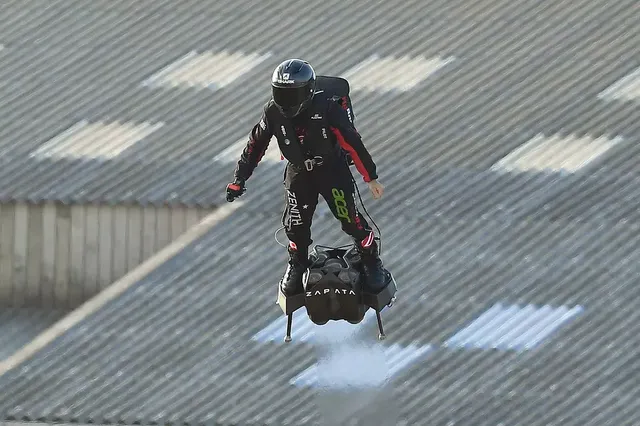French inventor successfully crosses the English Channel on a hoverboard
 Franky Zapata Attempts To Cross The English Channel On His Flyboard
Franky Zapata Attempts To Cross The English Channel On His Flyboard
Photo by Aurelien Meunier/Getty Images
After a failed attempt at the end of July, French inventor Franky Zapata successfully crossed the English Channel early this morning on his Flyboard Air, a jet-powered hoverboard.
Zapata departed from Sangatte, France and arrived in Dover, England 22 minutes later, reaching speeds of up to 106 miles per hour during the 22-mile trip. “We made a machine three years ago,” he said after landing, “and now, we’ve crossed the Channel, it’s crazy.”
The Guardian reports that the trip wasn’t a continuous one: because he only carried a 10-minute supply of fuel on his back, he had to make a pit stop at the halfway mark to refuel.
This was Zapata’s second attempt to cross the Channel: his first attempt at the end of July ended in failure when he fell into the water while trying to land on the refueling platform. He and his team chalked up the crash to the size of the waves during the landing attempt, forcing him to miss the edge of the platform by centimeters. After the crash, he said that they would make the attempt once again, this time using a slightly different route and a larger refueling platform.
Zapata invented the Flyboard in 2011, a device that uses a water jet to propel the rider through the air behind a boat. He later invented the Flyboard Air, a board powered by four turbojet engines that allow a rider to fly through the air untethered, using a computer to keep it stabilized. In 2016, Zapata set a world record for the farthest hoverboard flight after he flew the Flyboard Air along the south coast of France for 2,252 meters (about 1.4 miles).
The inventor made headlines in the middle of July when he appeared over crowds during France’s Bastille Day celebrations carrying a gun, a demonstration of some of the uses that the device could have. There has been some interest from the defense industry in the vehicle: defense contractor Implant Sciences had planned to acquire Zapata’s company, Zapata Industries (although that deal later fell through) and France’s defense and procurement agency granted Zapata a €1.3m grant in 2018 to help with the development of the vehicle.
Zapata isn’t the only person working on this sort of jet-powered personal transportation: English inventor Richard Browning developed a jet suit that allows the wearer to fly with six turbo-engines strapped to their arms, something he’s demonstrated to with everyone from the British Royal Marines, to Adam Savage.